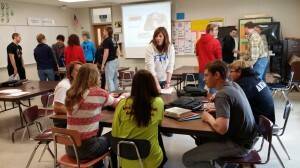Connect Farming to Food in the Classroom
Last week I had the pleasure of serving as a guest teacher for one day in the Hampton-Dumont High School. It’s been 44 years since I graduated from Hampton, which wasn’t part of a consolidated school system at that time. While many changes have occurred over the years, I found the students to be engaging and interested in the facts I shared with them.
I certainly enjoyed my time “at the head of the class,” teaching two of Jane Hoegh’s Food and Nutrition classes and had three of Sara DeBour’s Vo Ag classes as part of the National Pork Board’s Operation Main Street program. I’ve given about 50 presentations to civic groups as part of this group, but last week was the first time I spoke to young students in a classroom setting. In fact, I spoke to 95 kids in just one day!
Although we live in a rural county, many kids in that classroom had never visited a farm. I gave them a virtual tour by showing videos and explaining how we’ve improved our pig operations from the time I started farming 50 years ago. We have become much more efficient in producing pigs. We use much less ground and water per pig, and we have changed the pork we produce to be much healthier.
The food classes learned how many nutrients are in pork, making it a very nutritious food. Easy to prepare and very versatile. In 2006, pork passed chicken in leanness.
 In both classes, I shared that there are 7 billion (with a “b”) people in the world today. Half of those seven billion live on less than $2 dollars per day. Then we talked about what it’s going to take to grow enough food – on the same amount of ground we have now – as the population gains another 2.3 billion people by 2050. U.S. farmers will need to grow 100% more food by 2050 because these people will want to eat better as they acquire better incomes. (Click here to watch a short video explaining this.)
In both classes, I shared that there are 7 billion (with a “b”) people in the world today. Half of those seven billion live on less than $2 dollars per day. Then we talked about what it’s going to take to grow enough food – on the same amount of ground we have now – as the population gains another 2.3 billion people by 2050. U.S. farmers will need to grow 100% more food by 2050 because these people will want to eat better as they acquire better incomes. (Click here to watch a short video explaining this.)
Specifically in the Vo Ag classes, I went more into detail about how the hog buildings work. I explained the We CareTM initiative and how pig farmers work hard to do the right things for our pigs every day. We talked about how pork producers use medicines according to our veterinary recommendations, making sure all withdrawal times are met. Antibiotics leave the pigs bodies just like they do in humans, so there is no residue in the meat at the time of market.
Antibiotics are used to keeps our pigs healthy. We have other precautions in place, such as posted warning signs, to help prevent diseases from spreading through our herds. I explained to the students that these signs aren’t posted to hide anything. Instead, signs like “STOP Authorized Personnel Only Beyond This Point” are in place to protect pigs from disease. We had a good discussion on how cleanliness is key to animal health. I explained that pigs are raised on different sites as they grow to break the disease cycle, and I shared photos of how my barns are cleaned and sanitized before a new group of pigs arrive.
From the photos I shared of my hog barns, these students saw all of the technology involved to regulate temperatures and regulate fans. Kids understand technology since they’re growing up in the age of iPads, iPods, and things I can’t even name. Yes, today’s kids understand new ways to raise pigs!
I had a great time being “back” in school. I’m hopeful these kids will explain to their parents what I do every day and why I do it! I also hope they’ll be able to shop the grocery store and buy food for themselves with confidence.

